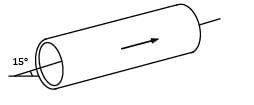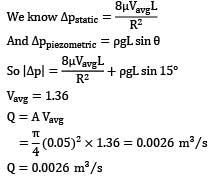Civil Engineering (CE) Exam > Civil Engineering (CE) Questions > Oil at 20°C (ρ = 888 kg⁄m3 and μ = 0.800 kg ...
Start Learning for Free
Oil at 20°C (ρ = 888 kg⁄m3 and μ = 0.800 kg ⁄ ms) is flowing steadily through a 5-cm-diameter 40-m-long pipe as shown in the below figure. The pressure at the pipe inlet and outlet are measured to be 745 and 97 kPa, respectively. Determine the flow rate of oil through the pipe (in m3/s) assuming the pipe is inclined 15° upward.

Correct answer is 'Range: 0.002 to 0.003'. Can you explain this answer?
Verified Answer
Oil at 20°C (ρ = 888 kg⁄m3 and μ = 0.800 kg ⁄ ms) is flowing steadily...
In this question the total pressure drop will be the addition of static pressure drop and the piezometric pressure drop.
View all questions of this test

Most Upvoted Answer
Oil at 20°C (ρ = 888 kg⁄m3 and μ = 0.800 kg ⁄ ms) is flowing steadily...
In this question the total pressure drop will be the addition of static pressure drop and the piezometric pressure drop.

Free Test
| FREE | Start Free Test |
Community Answer
Oil at 20°C (ρ = 888 kg⁄m3 and μ = 0.800 kg ⁄ ms) is flowing steadily...
In this question the total pressure drop will be the addition of static pressure drop and the piezometric pressure drop.


|
Explore Courses for Civil Engineering (CE) exam
|

|
Similar Civil Engineering (CE) Doubts
Oil at 20°C (ρ = 888 kg⁄m3 and μ = 0.800 kg ⁄ ms) is flowing steadily through a 5-cm-diameter 40-m-long pipe as shown in the below figure. The pressure at the pipe inlet and outlet are measured to be 745 and 97 kPa, respectively. Determine the flow rate of oil through the pipe (in m3/s) assuming the pipe is inclined 15° upward.Correct answer is 'Range: 0.002 to 0.003'. Can you explain this answer?
Question Description
Oil at 20°C (ρ = 888 kg⁄m3 and μ = 0.800 kg ⁄ ms) is flowing steadily through a 5-cm-diameter 40-m-long pipe as shown in the below figure. The pressure at the pipe inlet and outlet are measured to be 745 and 97 kPa, respectively. Determine the flow rate of oil through the pipe (in m3/s) assuming the pipe is inclined 15° upward.Correct answer is 'Range: 0.002 to 0.003'. Can you explain this answer? for Civil Engineering (CE) 2025 is part of Civil Engineering (CE) preparation. The Question and answers have been prepared according to the Civil Engineering (CE) exam syllabus. Information about Oil at 20°C (ρ = 888 kg⁄m3 and μ = 0.800 kg ⁄ ms) is flowing steadily through a 5-cm-diameter 40-m-long pipe as shown in the below figure. The pressure at the pipe inlet and outlet are measured to be 745 and 97 kPa, respectively. Determine the flow rate of oil through the pipe (in m3/s) assuming the pipe is inclined 15° upward.Correct answer is 'Range: 0.002 to 0.003'. Can you explain this answer? covers all topics & solutions for Civil Engineering (CE) 2025 Exam. Find important definitions, questions, meanings, examples, exercises and tests below for Oil at 20°C (ρ = 888 kg⁄m3 and μ = 0.800 kg ⁄ ms) is flowing steadily through a 5-cm-diameter 40-m-long pipe as shown in the below figure. The pressure at the pipe inlet and outlet are measured to be 745 and 97 kPa, respectively. Determine the flow rate of oil through the pipe (in m3/s) assuming the pipe is inclined 15° upward.Correct answer is 'Range: 0.002 to 0.003'. Can you explain this answer?.
Oil at 20°C (ρ = 888 kg⁄m3 and μ = 0.800 kg ⁄ ms) is flowing steadily through a 5-cm-diameter 40-m-long pipe as shown in the below figure. The pressure at the pipe inlet and outlet are measured to be 745 and 97 kPa, respectively. Determine the flow rate of oil through the pipe (in m3/s) assuming the pipe is inclined 15° upward.Correct answer is 'Range: 0.002 to 0.003'. Can you explain this answer? for Civil Engineering (CE) 2025 is part of Civil Engineering (CE) preparation. The Question and answers have been prepared according to the Civil Engineering (CE) exam syllabus. Information about Oil at 20°C (ρ = 888 kg⁄m3 and μ = 0.800 kg ⁄ ms) is flowing steadily through a 5-cm-diameter 40-m-long pipe as shown in the below figure. The pressure at the pipe inlet and outlet are measured to be 745 and 97 kPa, respectively. Determine the flow rate of oil through the pipe (in m3/s) assuming the pipe is inclined 15° upward.Correct answer is 'Range: 0.002 to 0.003'. Can you explain this answer? covers all topics & solutions for Civil Engineering (CE) 2025 Exam. Find important definitions, questions, meanings, examples, exercises and tests below for Oil at 20°C (ρ = 888 kg⁄m3 and μ = 0.800 kg ⁄ ms) is flowing steadily through a 5-cm-diameter 40-m-long pipe as shown in the below figure. The pressure at the pipe inlet and outlet are measured to be 745 and 97 kPa, respectively. Determine the flow rate of oil through the pipe (in m3/s) assuming the pipe is inclined 15° upward.Correct answer is 'Range: 0.002 to 0.003'. Can you explain this answer?.
Solutions for Oil at 20°C (ρ = 888 kg⁄m3 and μ = 0.800 kg ⁄ ms) is flowing steadily through a 5-cm-diameter 40-m-long pipe as shown in the below figure. The pressure at the pipe inlet and outlet are measured to be 745 and 97 kPa, respectively. Determine the flow rate of oil through the pipe (in m3/s) assuming the pipe is inclined 15° upward.Correct answer is 'Range: 0.002 to 0.003'. Can you explain this answer? in English & in Hindi are available as part of our courses for Civil Engineering (CE).
Download more important topics, notes, lectures and mock test series for Civil Engineering (CE) Exam by signing up for free.
Here you can find the meaning of Oil at 20°C (ρ = 888 kg⁄m3 and μ = 0.800 kg ⁄ ms) is flowing steadily through a 5-cm-diameter 40-m-long pipe as shown in the below figure. The pressure at the pipe inlet and outlet are measured to be 745 and 97 kPa, respectively. Determine the flow rate of oil through the pipe (in m3/s) assuming the pipe is inclined 15° upward.Correct answer is 'Range: 0.002 to 0.003'. Can you explain this answer? defined & explained in the simplest way possible. Besides giving the explanation of
Oil at 20°C (ρ = 888 kg⁄m3 and μ = 0.800 kg ⁄ ms) is flowing steadily through a 5-cm-diameter 40-m-long pipe as shown in the below figure. The pressure at the pipe inlet and outlet are measured to be 745 and 97 kPa, respectively. Determine the flow rate of oil through the pipe (in m3/s) assuming the pipe is inclined 15° upward.Correct answer is 'Range: 0.002 to 0.003'. Can you explain this answer?, a detailed solution for Oil at 20°C (ρ = 888 kg⁄m3 and μ = 0.800 kg ⁄ ms) is flowing steadily through a 5-cm-diameter 40-m-long pipe as shown in the below figure. The pressure at the pipe inlet and outlet are measured to be 745 and 97 kPa, respectively. Determine the flow rate of oil through the pipe (in m3/s) assuming the pipe is inclined 15° upward.Correct answer is 'Range: 0.002 to 0.003'. Can you explain this answer? has been provided alongside types of Oil at 20°C (ρ = 888 kg⁄m3 and μ = 0.800 kg ⁄ ms) is flowing steadily through a 5-cm-diameter 40-m-long pipe as shown in the below figure. The pressure at the pipe inlet and outlet are measured to be 745 and 97 kPa, respectively. Determine the flow rate of oil through the pipe (in m3/s) assuming the pipe is inclined 15° upward.Correct answer is 'Range: 0.002 to 0.003'. Can you explain this answer? theory, EduRev gives you an
ample number of questions to practice Oil at 20°C (ρ = 888 kg⁄m3 and μ = 0.800 kg ⁄ ms) is flowing steadily through a 5-cm-diameter 40-m-long pipe as shown in the below figure. The pressure at the pipe inlet and outlet are measured to be 745 and 97 kPa, respectively. Determine the flow rate of oil through the pipe (in m3/s) assuming the pipe is inclined 15° upward.Correct answer is 'Range: 0.002 to 0.003'. Can you explain this answer? tests, examples and also practice Civil Engineering (CE) tests.

|
Explore Courses for Civil Engineering (CE) exam
|

|
Signup for Free!
Signup to see your scores go up within 7 days! Learn & Practice with 1000+ FREE Notes, Videos & Tests.


























